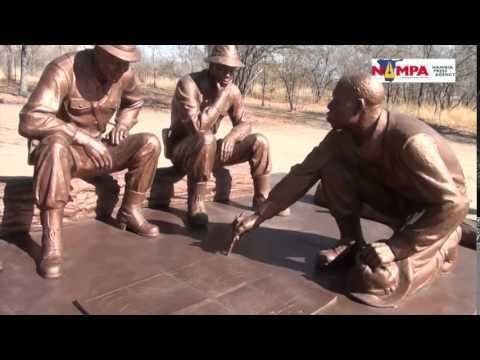 | ||
Nampa omugulugwombashe statue unveiled of sam nujoma 26 aug 2013
Omugulugwombashe (also: Omugulu-Gwombashe, Omugulu-gwOombashe, and Omgulumbashe, Otjiherero: giraffe leg) is a settlement in the Tsandi electoral constituency in the Omusati Region of northern Namibia. The settlement features a clinic and a primary school. In Omugulugwombashe the Namibian struggle for independence started in 1966. Government of Namibia erected a monument in honour of this battle at the thirtieth anniversary of the start of the conflict in 1996.
Contents
- Nampa omugulugwombashe statue unveiled of sam nujoma 26 aug 2013
- Nampa omugulugwombashe hundreds of mourners bury war hero ithete 07 sept 2014
- Battle at Omugulugwombashe
- Commemorations
- Omugulugwombashe Medal
- Omugulugwombashe Star
- References
Omugulugwombashe is located 22km west of Tsandi, on the D3633 gravel road.
Nampa omugulugwombashe hundreds of mourners bury war hero ithete 07 sept 2014
Battle at Omugulugwombashe
In 1966 the United Nations General Assembly revoked South Africa's mandate to govern South West African territory and placed it under direct UN administration. South Africa refused to recognize this resolution. South West African People's Organization (SWAPO) at that time prepared for armed resistance and founded its armed wing, the South West African Liberation Army (SWALA) in 1962. Many of its erstwhile commanders were in exile but SWALA began to infiltrate the north of Namibia to establish training camps. Omugulugwombashe was one such training camp, established in June 1966 by SWALA commander John Ya Otto Nankudhu. The group under Nankudhu had just started to build defensive structures and planned to train about 90 insurgents there.
On 26 August 1966, eight helicopters landed troops of the South African Defence Force and South African Police to attack the guerrilla fighters at Omugulugwombashe. At the time of attack there were only 17 insurgents in the camp. It was the first armed battle in the Namibian War of Independence. Among those SWALA fighters captured and imprisoned were:
Other guerrillas escaped but were detained in later years for their participation in the setup of the camp, for instance Lameck 'Kagwaanduka' Ithete who was arrested only in 1969. He served three years jail time in Pretoria for his involvement.
Commemorations
In commemoration of this day, August 26 is a public holiday in Namibia. It is recognized by the United Nations as Namibia Day but Namibians refer to it as Heroes' Day.
Omugulugwombashe today features one of Namibia's two state cemeteries, where national heroes are buried. It also contains a memorial shrine, inaugurated by Namibia's founding president Sam Nujoma, and a statue of the six soldiers leading the camp when the attacks started on August 26, inaugurated by Namibia's second president Hifikepunye Pohamba:
Omugulugwombashe Medal
Although the action, in itself, was of little military significance, it represents the first engagement in what would be a long, intense and ultimately successful conflict. As such, it retains a totemic value that continues to endure and is commemorated in the prestigious decoration for veterans of the Liberation War, the Omugulugwombashe Medal.
Omugulugwombashe Star
A further commemoration of the battle is the name given to the country's premier rail-service. Namibia's first luxury passenger train, from Windhoek to Ondangwa, was named the Omugulugwombashe Star on its inauguration, on July 15, 2006. This train, manufactured in China, was however grounded after a few rounds of service, because the locomotives packed up shortly after inception and were found unsuitable for Namibia’s railway network. Afterwards, the weekly train service to Ondangwa was stopped.
